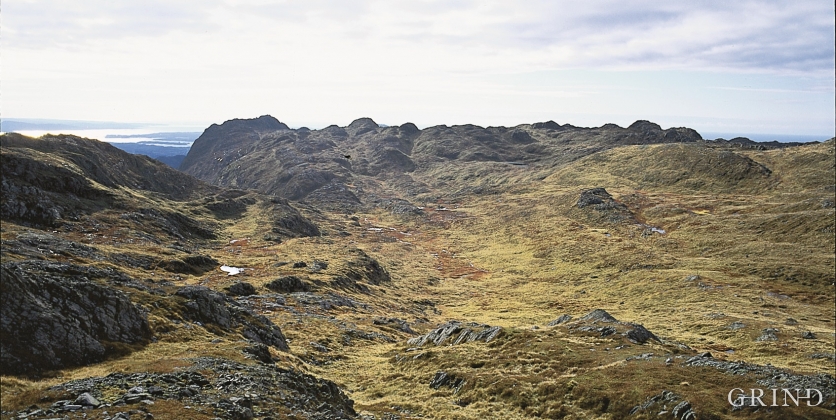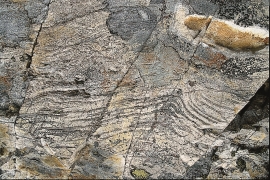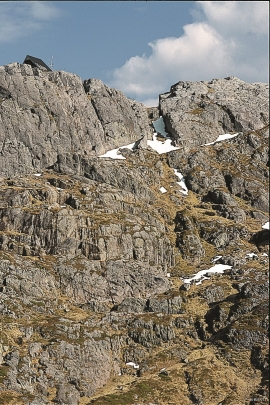Published: 22.07.2015 | Author: Haakon Fossen
Stordfjella mountain towards the south. Stovegolvet in the background above. (Svein Nord)
MOUNTAIN PLATEAU IN VOLCANIC TERRAIN
The highest mountainous area on Stord, including Kattnakken, Midtfjellet and Stovegolvet, has more in common with the mountainous terrain on the mainland than in the low coastal landscape of Sunnhordland. The volcanic bedrock together with the erosive powers of nature has resulted in a unique plateau landscape.
Seen from a distance, the mountains on Stord comprise a big plateau. This level mountainous area is the remains of a flat land that once stretched all the way from Hardangervidda out toward the coast, before the land a few million years ago became uplifted and carved up, first by rivers and later by glaciers (T60). The plateau remains today because the hard, volcanic bedrock is difficult to erode away. These volcanic layers are related to a comparable layer in the Siggjo-area of Bømlo and they vary from basalts to acidic rhyolite lavas. In some of the acidic volcanic rocktypes one can see marks left by the lava flows. Other rock types were formed by the ashfall. During the same eruption the ash got so hot that it became welded together and formed hard rock. These eruptions are believed to have resembled the famous eruptions of Vesuvius, that covered the city of Pompeii in the year 79.
It isn't as flat on the top of the plateau as one would expect looking from a distance. Small valleys, weathered out along two distinctive fracture zones, have divided up the plateau into hills and crags. Not without reason, the smaller mountain area is called Skorafjellet ("carved mountain"). Stovegolvet is the name of a flat, little area far to the south on the plateau. On Kattnakken, the flatness is disrupted by two narrow ravines with walls so straight that they could have been carved by a knife. In Triassic times the basaltic magma intruded up into the big fracture zones and solidified to diabase. The gorges that follow these zones show that the diabase veins weather out faster than the older, more acidic volcanic rocks round about. The phyllite south of the plateau has even less resistance to the forces of nature. The precipice from Jektevik and Uføro over the west side of Kattnakken and further past Stovegolvet marks the transition from hard volcanic bedrock in the mountainous area to the softer phyllite-like rocktypes in the lowland.
The structure in the rhyolite lava along Kattnakken's steep slope lasted until lava flowed out from an ancient volcano. Along the road cut above the toll bar, the rhyolite is dark and hard like flint. The light colour is derived from many thousands of years of weathering of the feldspar minerals in the lava. (Haakon Fossen)
Stovegolvet is carved out of volcanic bedrock. About 220 million years ago, glowing lava intruded into cracks in the mountainside. The magma solidified to a diabase vein that now forms a distinctive depression. Here seen from the north, the depression with the vein a little to the right of centre in the picture. (Haakon Fossen)
- Lippard, S. J.; Mitchell, J. G. Late Caledonian dolerites from the Katnakken area, Stord,SW Norway, their age and tectonic significance. 1980. Norges Geologiske Undersøkelse Bulletin 358:47–62.





